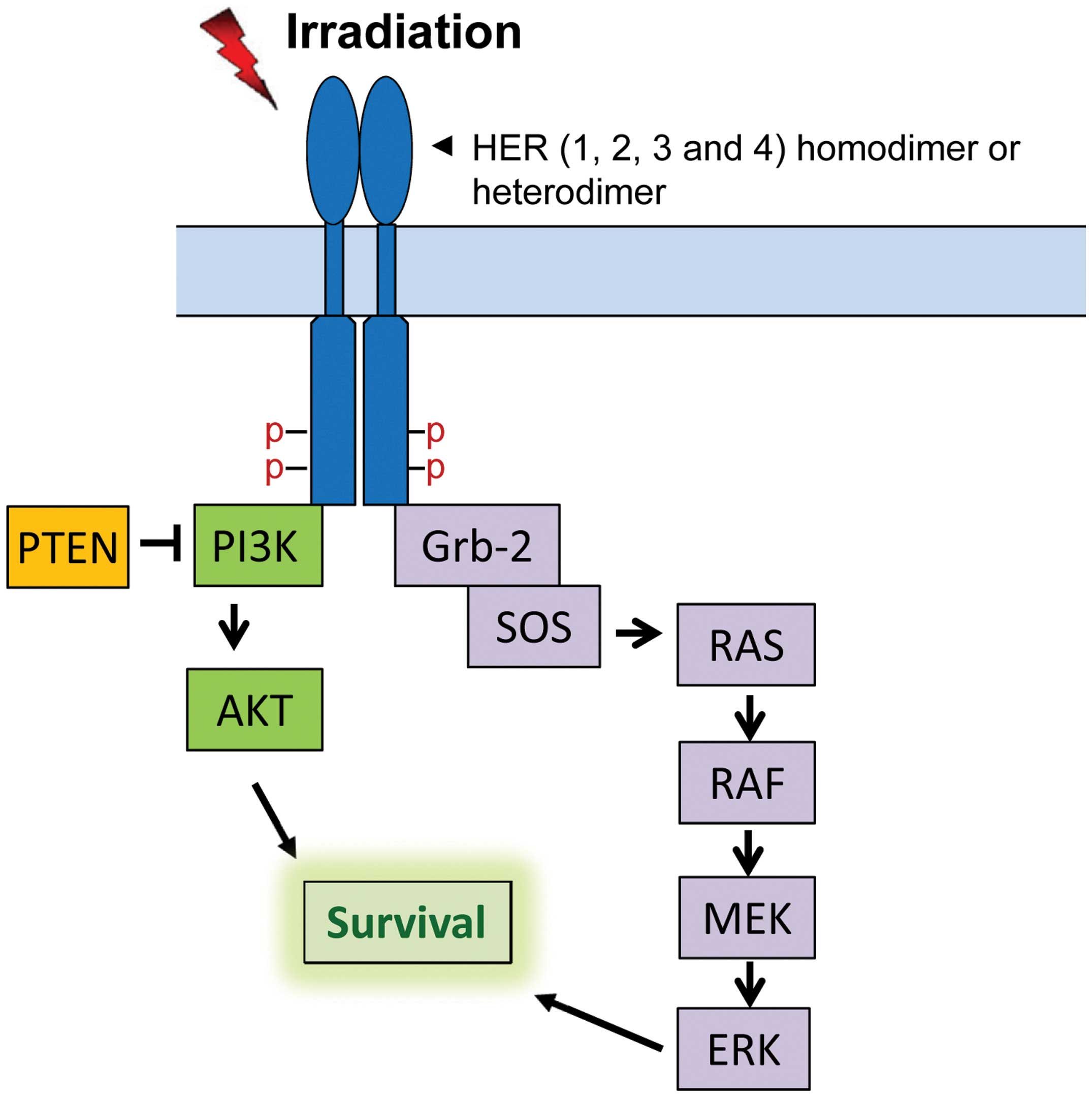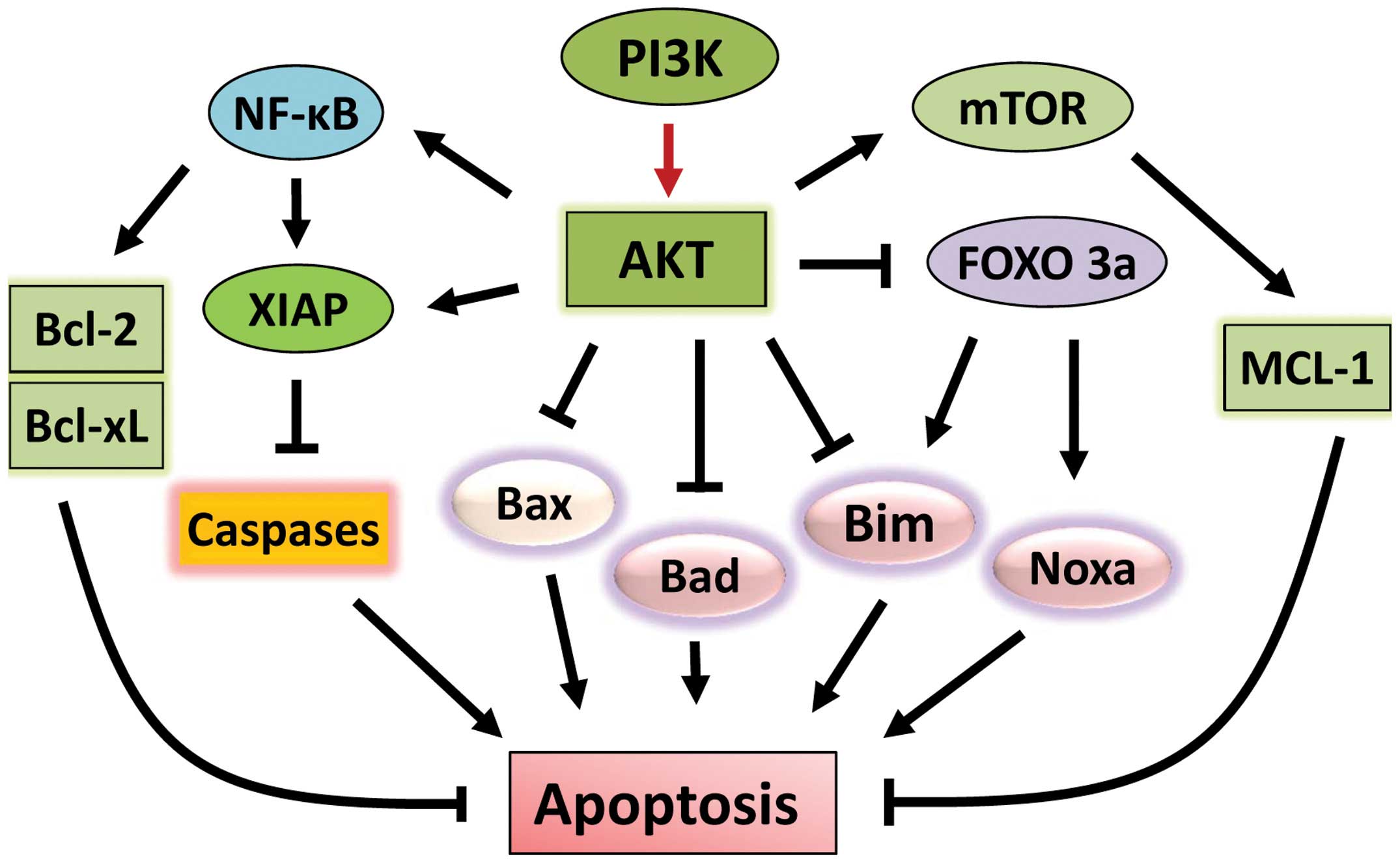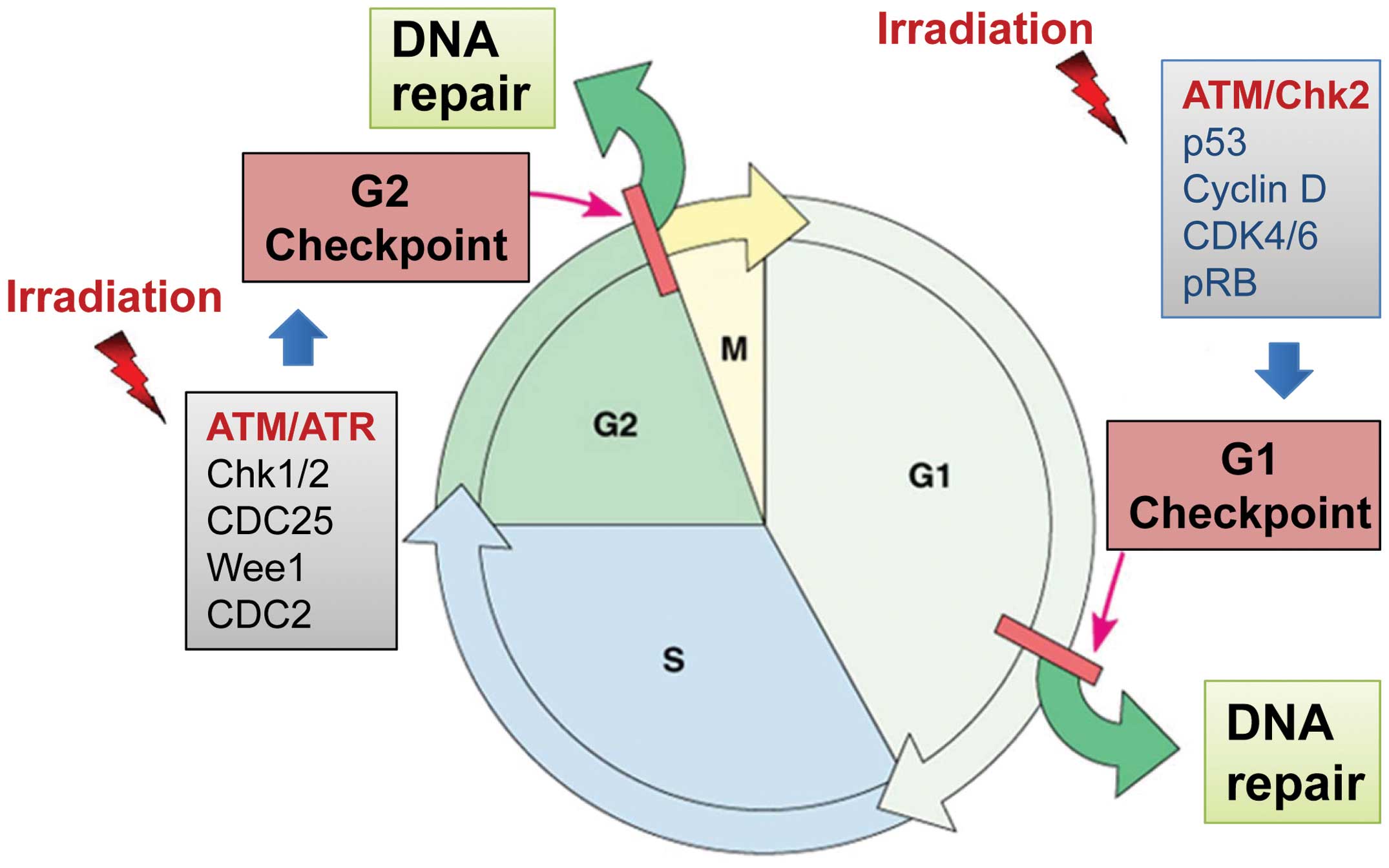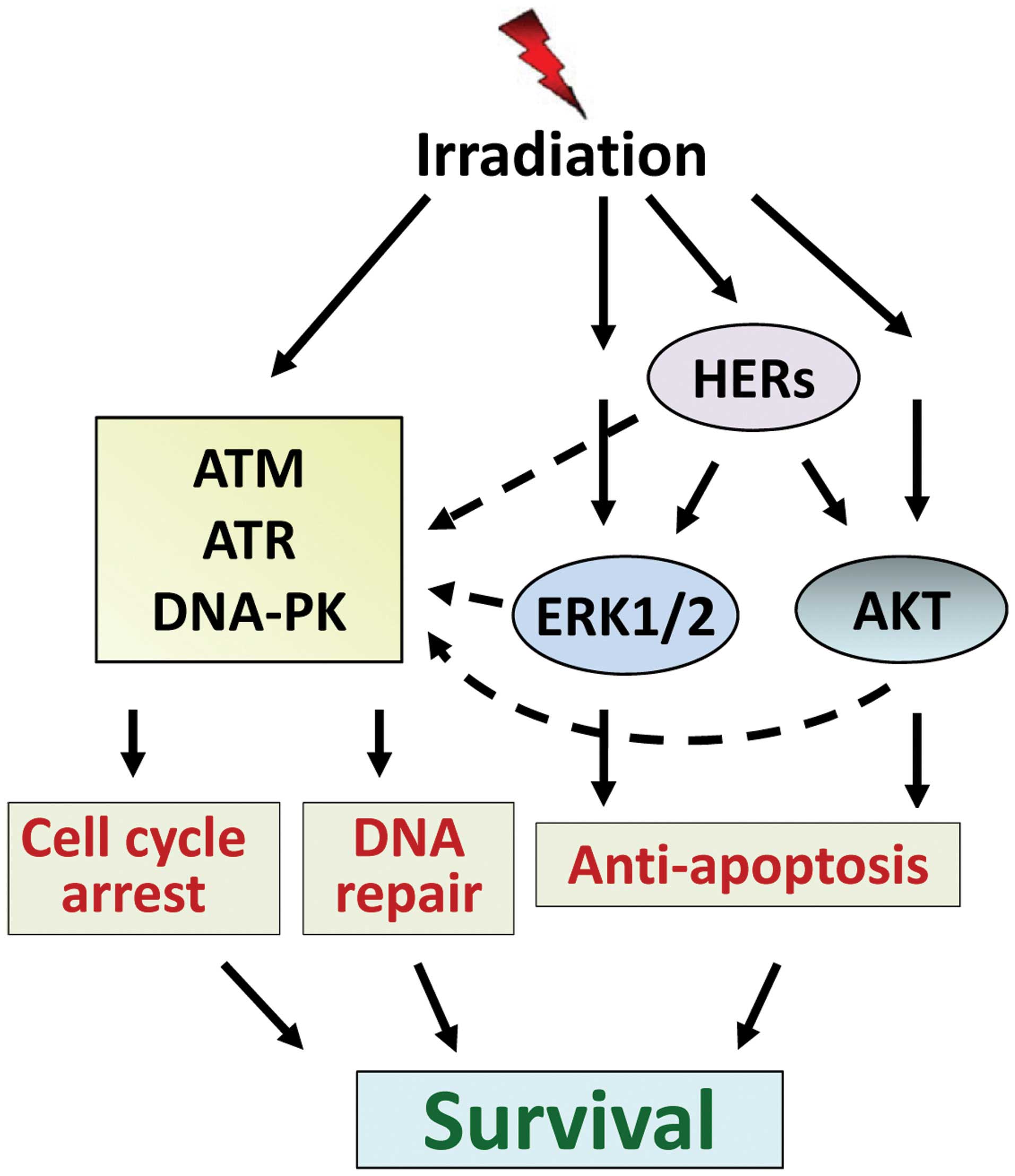|
1
|
Pignon JP, le Maitre A, Maillard E and
Bourhis J: Meta-analysis of chemotherapy in head and neck cancer
(MACH-NC): an update on 93 randomised trials and 17,346 patients.
Radiother Oncol. 92:4–14. 2009. View Article : Google Scholar : PubMed/NCBI
|
|
2
|
Ramnath N, Dilling TJ, Harris LJ, et al:
Treatment of stage III non-small cell lung cancer: diagnosis and
management of lung cancer, 3rd ed: American College of Chest
Physicians evidence-based clinical practice guidelines. Chest.
143:eS314–eS340. 2013. View Article : Google Scholar
|
|
3
|
Wilkinson-Ryan I, Binder PS,
Pourabolghasem S, et al: Concomitant chemotherapy and radiation for
the treatment of advanced-stage endometrial cancer. Gynecol Oncol.
134:24–28. 2014. View Article : Google Scholar : PubMed/NCBI
|
|
4
|
Johnstone RW, Ruefli AA and Lowe SW:
Apoptosis: a link between cancer genetics and chemotherapy. Cell.
108:153–164. 2002. View Article : Google Scholar : PubMed/NCBI
|
|
5
|
Milas L, Raju U, Liao Z and Ajani J:
Targeting molecular determinants of tumor chemo-radioresistance.
Semin Oncol. 32:S78–S81. 2005. View Article : Google Scholar : PubMed/NCBI
|
|
6
|
Bernier J: Current state-of-the-art for
concurrent chemoradiation. Semin Radiat Oncol. 19:3–10. 2009.
View Article : Google Scholar : PubMed/NCBI
|
|
7
|
Ghiam AF, Spayne J and Lee J: Current
challenges and future perspectives of radiotherapy for locally
advanced breast cancer. Curr Opin Support Palliat Care. 8:46–52.
2014. View Article : Google Scholar : PubMed/NCBI
|
|
8
|
Gewirtz DA: Growth arrest and cell death
in the breast tumor cell in response to ionizing radiation and
chemotherapeutic agents which induce DNA damage. Breast Cancer Res
Treat. 62:223–235. 2000. View Article : Google Scholar
|
|
9
|
Hawkins AJ, Golding SE, Khalil A and
Valerie K: DNA double-strand break-induced pro-survival signaling.
Radiother Oncol. 101:13–17. 2011. View Article : Google Scholar : PubMed/NCBI
|
|
10
|
Raleigh DR and Haas-Kogan DA: Molecular
targets and mechanisms of radiosensitization using DNA damage
response pathways. Future Oncol. 9:219–233. 2013. View Article : Google Scholar : PubMed/NCBI
|
|
11
|
Navolanic PM, Steelman LS and McCubrey JA:
EGFR family signaling and its association with breast cancer
development and resistance to chemotherapy (Review). Int J Oncol.
22:237–252. 2003.PubMed/NCBI
|
|
12
|
Linggi B and Carpenter G: ErbB receptors:
new insights on mechanisms and biology. Trends Cell Biol.
16:649–656. 2006. View Article : Google Scholar : PubMed/NCBI
|
|
13
|
Arteaga Carlos L and Engelman Jeffrey A:
ERBB receptors: from oncogene discovery to basic science to
mechanism-based cancer therapeutics. Cancer Cell. 25:282–303.
2014.PubMed/NCBI
|
|
14
|
Rexer BN and Arteaga CL: Intrinsic and
acquired resistance to HER2-targeted therapies in HER2
gene-amplified breast cancer: mechanisms and clinical implications.
Crit Rev Oncog. 17:1–16. 2012. View Article : Google Scholar : PubMed/NCBI
|
|
15
|
Valerie K, Yacoub A, Hagan MP, et al:
Radiation-induced cell signaling: inside-out and outside-in. Mol
Cancer Ther. 6:789–801. 2007. View Article : Google Scholar : PubMed/NCBI
|
|
16
|
Goldkorn T, Balaban N, Shannon M and
Matsukuma K: EGF receptor phosphorylation is affected by ionizing
radiation. Biochim Biophys Acta. 1358:289–299. 1997. View Article : Google Scholar : PubMed/NCBI
|
|
17
|
Lee H-C, An S, Lee H, et al: Activation of
epidermal growth factor receptor and its downstream signaling
pathway by nitric oxide in response to ionizing radiation. Mol
Cancer Res. 6:996–1002. 2008. View Article : Google Scholar : PubMed/NCBI
|
|
18
|
Kiyozuka M, Akimoto T, Fukutome M, Motegi
A and Mitsuhashi N: Radiation-induced dimer formation of EGFR:
implications for the radiosensitizing effect of cetuximab.
Anticancer Res. 33:4337–4346. 2013.PubMed/NCBI
|
|
19
|
Yan Y, Hein AL, Greer PM, et al: A novel
function of HER2/Neu in the activation of G2/M checkpoint in
response to [gamma]-irradiation. Oncogene. June 9–2014.(Epub ahead
of print). View Article : Google Scholar
|
|
20
|
Meng TC, Fukada T and Tonks NK: Reversible
oxidation and inactivation of protein tyrosine phosphatases in
vivo. Mol Cell. 9:387–399. 2002. View Article : Google Scholar : PubMed/NCBI
|
|
21
|
Leach JK, Van Tuyle G, Lin PS,
Schmidt-Ullrich R and Mikkelsen RB: Ionizing radiation-induced,
mitochondria-dependent generation of reactive oxygen/nitrogen.
Cancer Res. 61:3894–3901. 2001.PubMed/NCBI
|
|
22
|
Nyati MK, Maheshwari D, Hanasoge S, et al:
Radiosensitization by Pan ErbB Inhibitor CI-1033 in vitro and in
vivo. Clin Cancer Res. 10:691–700. 2004. View Article : Google Scholar
|
|
23
|
Liang K, Lu Y, Jin W, Ang KK, Milas L and
Fan Z: Sensitization of breast cancer cells to radiation by
trastuzumab. Mol Cancer Ther. 2:1113–1120. 2003.PubMed/NCBI
|
|
24
|
Geoerger B, Gaspar N, Opolon P, et al:
EGFR tyrosine kinase inhibition radiosensitizes and induces
apoptosis in malignant glioma and childhood ependymoma xenografts.
Int J Cancer. 123:209–216. 2008. View Article : Google Scholar : PubMed/NCBI
|
|
25
|
Dittmann K, Mayer C, Fehrenbacher B, et
al: Radiation-induced epidermal growth factor receptor nuclear
import is linked to activation of DNA-dependent protein kinase. J
Biol Chem. 280:31182–31189. 2005. View Article : Google Scholar : PubMed/NCBI
|
|
26
|
Dittmann K, Mayer C and Rodemann HP:
Inhibition of radiation-induced EGFR nuclear import by C225
(Cetuximab) suppresses DNA-PK activity. Radiother Oncol.
76:157–161. 2005. View Article : Google Scholar : PubMed/NCBI
|
|
27
|
Dent P, Yacoub A, Fisher PB, Hagan MP and
Grant S: MAPK pathways in radiation responses. Oncogene.
22:5885–5896. 2003. View Article : Google Scholar : PubMed/NCBI
|
|
28
|
Cui W, Yazlovitskaya EM, Mayo MS, Pelling
JC and Persons DL: Cisplatin-induced response of c-jun N-terminal
kinase 1 and extracellular signal-regulated protein kinases 1 and 2
in a series of cisplatin-resistant ovarian carcinoma cell lines.
Mol Carcinog. 29:219–228. 2000. View Article : Google Scholar
|
|
29
|
Abbott DW and Holt JT: Mitogen-activated
protein kinase kinase 2 activation is essential for progression
through the G2/M checkpoint arrest in cells exposed to ionizing
radiation. J Biol Chem. 274:2732–2742. 1999. View Article : Google Scholar : PubMed/NCBI
|
|
30
|
Tang D, Wu D, Hirao A, et al: ERK
activation mediates cell cycle arrest and apoptosis after DNA
damage independently of p53. J Biol Chem. 277:12710–12717. 2002.
View Article : Google Scholar : PubMed/NCBI
|
|
31
|
Yan Y, Black CP and Cowan KH:
Irradiation-induced G2/M checkpoint response requires ERK1/2
activation. Oncogene. 26:4689–4698. 2007. View Article : Google Scholar : PubMed/NCBI
|
|
32
|
Munshi A and Ramesh R: Mitogen-activated
protein kinases and their role in radiation response. Genes Cancer.
4:401–408. 2013. View Article : Google Scholar : PubMed/NCBI
|
|
33
|
Boucher MJ, Morisset J, Vachon PH, Reed
JC, Laine J and Rivard N: MEK/ERK signaling pathway regulates the
expression of Bcl-2, Bcl-X(L), and Mcl-1 and promotes survival of
human pancreatic cancer cells. J Cell Biochem. 79:355–369. 2000.
View Article : Google Scholar : PubMed/NCBI
|
|
34
|
Aoudjit F and Vuori K: Matrix attachment
regulates Fas-induced apoptosis in endothelial cells: a role for
c-flip and implications for anoikis. J Cell Biol. 152:633–643.
2001. View Article : Google Scholar : PubMed/NCBI
|
|
35
|
Jost M, Huggett TM, Kari C, Boise LH and
Rodeck U: Epidermal growth factor receptor-dependent control of
keratinocyte survival and Bcl-xL expression through a MEK-dependent
pathway. J Biol Chem. 276:6320–6326. 2001. View Article : Google Scholar : PubMed/NCBI
|
|
36
|
Bonni A, Brunet A, West AE, Datta SR,
Takasu MA and Greenberg ME: Cell survival promoted by the Ras-MAPK
signaling pathway by transcription-dependent and -independent
mechanisms. Science. 286:1358–1362. 1999. View Article : Google Scholar : PubMed/NCBI
|
|
37
|
Clark CJ, McDade DM, O’Shaughnessy CT and
Morris BJ: Contrasting roles of neuronal Msk1 and Rsk2 in Bad
phosphorylation and feedback regulation of Erk signalling. J
Neurochem. 102:1024–1034. 2007. View Article : Google Scholar : PubMed/NCBI
|
|
38
|
Ewings KE, Hadfield-Moorhouse K, Wiggins
CM, et al: ERK1/2-dependent phosphorylation of BimEL promotes its
rapid dissociation from Mcl-1 and Bcl-xL. EMBO J. 26:2856–2867.
2007. View Article : Google Scholar : PubMed/NCBI
|
|
39
|
Allan LA, Morrice N, Brady S, Magee G,
Pathak S and Clarke PR: Inhibition of caspase-9 through
phosphorylation at Thr 125 by ERK MAPK. Nat Cell Biol. 5:647–654.
2003. View Article : Google Scholar : PubMed/NCBI
|
|
40
|
Tamamoto T, Ohnishi K, Takahashi A, et al:
Correlation between gamma-ray-induced G2 arrest and radioresistance
in two human cancer cells. Int J Radiat Oncol Biol Phys.
44:905–909. 1999. View Article : Google Scholar : PubMed/NCBI
|
|
41
|
Fritz G, Brachetti C and Kaina B:
Lovastatin causes sensitization of HeLa cells to ionizing
radiation-induced apoptosis by the abrogation of G2 blockage. Int J
Radiat Biol. 79:601–610. 2003. View Article : Google Scholar : PubMed/NCBI
|
|
42
|
Yan Y, Black CP, Cao PT, et al:
Gamma-irradiation-induced DNA damage checkpoint activation involves
feedback regulation between extracellular signal-regulated kinase
1/2 and BRCA1. Cancer Res. 68:5113–5121. 2008. View Article : Google Scholar
|
|
43
|
Yacoub A, McKinstry R, Hinman D, Chung T,
Dent P and Hagan MP: Epidermal growth factor and ionizing radiation
up-regulate the DNA repair genes XRCC1 and ERCC1 in DU145 and LNCaP
prostate carcinoma through MAPK signaling. Radiat Res. 159:439–452.
2003. View Article : Google Scholar : PubMed/NCBI
|
|
44
|
Golding SE, Morgan RN, Adams BR, Hawkins
AJ, Povirk LF and Valerie K: Pro-survival AKT and ERK signaling
from EGFR and mutant EGFRvIII enhances DNA double-strand break
repair in human glioma cells. Cancer Biol Ther. 8:730–738. 2009.
View Article : Google Scholar : PubMed/NCBI
|
|
45
|
Wei F, Yan J, Tang D, et al: Inhibition of
ERK activation enhances the repair of double-stranded breaks via
non-homologous end joining by increasing DNA-PKcs activation.
Biochim Biophys Acta. 1833.90–100. 2013.PubMed/NCBI
|
|
46
|
Cohen-Armon M: PARP-1 activation in the
ERK signaling pathway. Trends Pharmacol Sci. 28:556–560. 2007.
View Article : Google Scholar : PubMed/NCBI
|
|
47
|
Cohen-Armon M, Visochek L, Rozensal D, et
al: DNA-independent PARP-1 activation by phosphorylated ERK2
increases Elk1 activity: a link to histone acetylation. Mol Cell.
25:297–308. 2007. View Article : Google Scholar : PubMed/NCBI
|
|
48
|
Golding SE, Rosenberg E, Neill S, Dent P,
Povirk LF and Valerie K: Extracellular signal-related kinase
positively regulates ataxia telangiectasia mutated, homologous
recombination repair, and the DNA damage response. Cancer Res.
67:1046–1053. 2007. View Article : Google Scholar
|
|
49
|
Yan Y, Greer PM, Cao PT, Kolb RH and Cowan
KH: RAC1 GTPase plays an important role in gamma-irradiation
induced G2/M checkpoint activation. Breast Cancer Res. 14:R602012.
View Article : Google Scholar : PubMed/NCBI
|
|
50
|
Sasaoka T, Langlois WJ, Leitner JW,
Draznin B and Olefsky JM: The signaling pathway coupling epidermal
growth factor receptors to activation of p21ras. J Biol Chem.
269:32621–32625. 1994.PubMed/NCBI
|
|
51
|
Janes PW, Daly RJ, deFazio A and
Sutherland RL: Activation of the Ras signalling pathway in human
breast cancer cells overexpressing erbB-2. Oncogene. 9:3601–3608.
1994.PubMed/NCBI
|
|
52
|
Dent P, Reardon DB, Park JS, et al:
Radiation-induced release of transforming growth factor alpha
activates the epidermal growth factor receptor and
mitogen-activated protein kinase pathway in carcinoma cells,
leading to increased proliferation and protection from
radiation-induced cell death. Mol Biol Cell. 10:2493–2506.
1999.
|
|
53
|
Hagan M, Wang L, Hanley JR, Park JS and
Dent P: Ionizing radiation-induced mitogen-activated protein (MAP)
kinase activation in DU145 prostate carcinoma cells: MAP kinase
inhibition enhances radiation-induced cell killing and G2/M-phase
arrest. Radiat Res. 153:371–383. 2000. View Article : Google Scholar
|
|
54
|
Polivka J Jr and Janku F: Molecular
targets for cancer therapy in the PI3K/AKT/mTOR pathway. Pharmacol
Ther. 142:164–175. 2014. View Article : Google Scholar : PubMed/NCBI
|
|
55
|
Yamaguchi H and Wang HG: The protein
kinase PKB/Akt regulates cell survival and apoptosis by inhibiting
Bax conformational change. Oncogene. 20:7779–7786. 2001. View Article : Google Scholar : PubMed/NCBI
|
|
56
|
Gardai SJ, Hildeman DA, Frankel SK, et al:
Phosphorylation of Bax Ser184 by Akt regulates its activity and
apoptosis in neutrophils. J Biol Chem. 279:21085–21095. 2004.
View Article : Google Scholar : PubMed/NCBI
|
|
57
|
Qi XJ, Wildey GM and Howe PH: Evidence
that Ser87 of BimEL is phosphorylated by Akt and regulates BimEL
apoptotic function. J Biol Chem. 281:813–823. 2006. View Article : Google Scholar : PubMed/NCBI
|
|
58
|
Engström M, Karlsson R and Jönsson J-I:
Inactivation of the forkhead transcription factor FoxO3 is
essential for PKB-mediated survival of hematopoietic progenitor
cells by kit ligand. Exp Hematol. 31:316–323. 2003.PubMed/NCBI
|
|
59
|
Yang JY, Xia W and Hu MC: Ionizing
radiation activates expression of FOXO3a, Fas ligand, and Bim, and
induces cell apoptosis. Int J Oncol. 29:643–648. 2006.PubMed/NCBI
|
|
60
|
Obexer P, Geiger K, Ambros PF, Meister B
and Ausserlechner MJ: FKHRL1-mediated expression of Noxa and Bim
induces apoptosis via the mitochondria in neuroblastoma cells. Cell
Death Differ. 14:534–547. 2007. View Article : Google Scholar : PubMed/NCBI
|
|
61
|
Jang S-W, Yang S-J, Srinivasan S and Ye K:
Akt phosphorylates MstI and prevents its proteolytic activation,
blocking FOXO3 phosphorylation and nuclear translocation. J Biol
Chem. 282:30836–30844. 2007. View Article : Google Scholar : PubMed/NCBI
|
|
62
|
Ozes ON, Mayo LD, Gustin JA, Pfeffer SR,
Pfeffer LM and Donner DB: NF-kappaB activation by tumour necrosis
factor requires the Akt serine-threonine kinase. Nature. 401:82–85.
1999. View Article : Google Scholar : PubMed/NCBI
|
|
63
|
Dan HC, Sun M, Kaneko S, et al: Akt
phosphorylation and stabilization of X-linked inhibitor of
apoptosis protein (XIAP). J Biol Chem. 279:5405–5412. 2004.
View Article : Google Scholar : PubMed/NCBI
|
|
64
|
Shaw RJ and Cantley LC: Ras, PI(3)K and
mTOR signalling controls tumour cell growth. Nature. 441:424–430.
2006. View Article : Google Scholar : PubMed/NCBI
|
|
65
|
Fumarola C, Bonelli MA, Petronini PG and
Alfieri RR: Targeting PI3K/AKT/mTOR pathway in non small cell lung
cancer. Biochem Pharmacol. 90:197–207. 2014. View Article : Google Scholar : PubMed/NCBI
|
|
66
|
Fleckenstein K, Zgonjanin L, Chen L, et
al: Temporal onset of hypoxia and oxidative stress after pulmonary
irradiation. Int J Radiat Oncol Biol Phys. 68:196–204. 2007.
View Article : Google Scholar : PubMed/NCBI
|
|
67
|
Sendoel A and Hengartner MO: Apoptotic
cell death under hypoxia. Physiology. 29:168–176. 2014. View Article : Google Scholar
|
|
68
|
King TD, Bijur GN and Jope RS: Caspase-3
activation induced by inhibition of mitochondrial complex I is
facilitated by glycogen synthase kinase-3β and attenuated by
lithium. Brain Res. 919:106–114. 2001.
|
|
69
|
Loberg RD, Vesely E and Brosius FC:
Enhanced glycogen synthase kinase-3β activity mediates
hypoxia-induced apoptosis of vascular smooth muscle cells and is
prevented by glucose transport and metabolism. J Biol Chem.
277:41667–41673. 2002.
|
|
70
|
Toulany M, Kehlbach R, Florczak U, et al:
Targeting of AKT1 enhances radiation toxicity of human tumor cells
by inhibiting DNA-PKcs-dependent DNA double-strand break repair.
Mol Cancer Ther. 7:1772–1781. 2008. View Article : Google Scholar : PubMed/NCBI
|
|
71
|
Soltoff SP, Carraway KL III, Prigent SA,
Gullick WG and Cantley LC: ErbB3 is involved in activation of
phosphatidylinositol 3-kinase by epidermal growth factor. Int J
Radiat Biol. 14:3550–3558. 1994.PubMed/NCBI
|
|
72
|
Marone R, Cmiljanovic V, Giese B and
Wymann MP: Targeting phosphoinositide 3-kinase - moving towards
therapy. Biochim Biophys Acta. 1784:159–185. 2008. View Article : Google Scholar : PubMed/NCBI
|
|
73
|
Toulany M, Baumann M and Rodemann HP:
Stimulated PI3K-AKT signaling mediated through ligand or
radiation-induced EGFR depends indirectly, but not directly, on
constitutive K-Ras activity. Mol Cancer Res. 5:863–872. 2007.
View Article : Google Scholar : PubMed/NCBI
|
|
74
|
Minjgee M, Toulany M, Kehlbach R, Giehl K
and Rodemann HP: K-RAS(V12) induces autocrine production of EGFR
ligands and mediates radioresistance through EGFR-dependent Akt
signaling and activation of DNA-PKcs. Int J Radiat Oncol Biol Phys.
81:1506–1514. 2011. View Article : Google Scholar : PubMed/NCBI
|
|
75
|
Toulany M, Lee K-J, Fattah KR, et al: Akt
promotes post-irradiation survival of human tumor cells through
initiation, progression, and termination of DNA-PKcs-dependent DNA
double-strand break repair. Mol Cancer Res. 10:945–957. 2012.
View Article : Google Scholar
|
|
76
|
Sahlberg SH, Gustafsson AS, Pendekanti PN,
Glimelius B and Stenerlow B: The influence of AKT isoforms on
radiation sensitivity and DNA repair in colon cancer cell lines.
Tumour Biol. 35:3525–3534. 2014. View Article : Google Scholar : PubMed/NCBI
|
|
77
|
Shimura T, Kakuda S, Ochiai Y, Kuwahara Y,
Takai Y and Fukumoto M: Targeting the AKT/GSK3β/cyclin D1/Cdk4
survival signaling pathway for eradication of tumor radioresistance
acquired by fractionated radiotherapy. Int J Radiat Oncol Biol
Phys. 80:540–548. 2011.
|
|
78
|
Kim IA, Bae SS, Fernandes A, et al:
Selective inhibition of Ras, phosphoinositide 3 kinase, and Akt
isoforms increases the radiosensitivity of human carcinoma cell
lines. Cancer Res. 65:7902–7910. 2005.PubMed/NCBI
|
|
79
|
Contessa JN, Hampton J, Lammering G, et
al: Ionizing radiation activates Erb-B receptor dependent Akt and
p70 S6 kinase signaling in carcinoma cells. Oncogene. 21:4032–4041.
2002. View Article : Google Scholar : PubMed/NCBI
|
|
80
|
Kastan MB, Onyekwere O, Sidransky D,
Vogelstein B and Craig RW: Participation of p53 protein in the
cellular response to DNA damage. Cancer Res. 51:6304–6311.
1991.PubMed/NCBI
|
|
81
|
Shonai T, Adachi M, Sakata K, et al:
MEK/ERK pathway protects ionizing radiation-induced loss of
mitochondrial membrane potential and cell death in lymphocytic
leukemia cells. Cell Death Differ. 9:963–971. 2002. View Article : Google Scholar : PubMed/NCBI
|
|
82
|
Lee YJ, Soh JW, Jeoung DI, et al: PKC
epsilon-mediated ERK1/2 activation involved in radiation-induced
cell death in NIH3T3 cells. Biochim Biophys Acta. 1593:219–229.
2003. View Article : Google Scholar : PubMed/NCBI
|
|
83
|
Dai X-F, Ding J, Zhang R-G, Ren J-H, Ma
C-MC and Wu G: Radiosensitivity enhancement of human hepatocellular
carcinoma cell line SMMC-7721 by sorafenib through the MEK/ERK
signal pathway. Int J Radiat Biol. 89:12013.PubMed/NCBI
|
|
84
|
Sancar A, Lindsey-Boltz LA, Unsal-Kacmaz K
and Linn S: Molecular mechanisms of mammalian DNA repair and the
DNA damage checkpoints. Annu Rev Biochem. 73:39–85. 2004.
View Article : Google Scholar : PubMed/NCBI
|
|
85
|
Smits VA and Medema RH: Checking out the
G(2)/M transition. Biochim Biophys Acta. 1519:1–12. 2001.
View Article : Google Scholar : PubMed/NCBI
|
|
86
|
O’Connell MJ and Cimprich KA: G2 damage
checkpoints: what is the turn-on? J Cell Sci. 118:1–6.
2005.PubMed/NCBI
|
|
87
|
Chen T, Stephens PA, Middleton FK and
Curtin NJ: Targeting the S and G2 checkpoint to treat cancer. Drug
Discov Today. 17:194–202. 2012. View Article : Google Scholar : PubMed/NCBI
|
|
88
|
Kharbanda S, Saleem A, Datta R, Yuan ZM,
Weichselbaum R and Kufe D: Ionizing radiation induces rapid
tyrosine phosphorylation of p34cdc2. Cancer Res. 54:1412–1414.
1994.PubMed/NCBI
|
|
89
|
Rhind N, Furnari B and Russell P: Cdc2
tyrosine phosphorylation is required for the DNA damage checkpoint
in fission yeast. Genes Dev. 11:504–511. 1997. View Article : Google Scholar
|
|
90
|
O’Connell MJ, Raleigh JM, Verkade HM and
Nurse P: Chk1 is a wee1 kinase in the G2 DNA damage checkpoint
inhibiting cdc2 by Y15 phosphorylation. EMBO J. 16:545–554.
1997.PubMed/NCBI
|
|
91
|
Lundgren K, Walworth N, Booher R, Dembski
M, Kirschner M and Beach D: mik1 and wee1 cooperate in the
inhibitory tyrosine phosphorylation of cdc2. Cell. 64:1111–1122.
1991. View Article : Google Scholar
|
|
92
|
Parker LL, Atherton-Fessler S and
Piwnica-Worms H: p107wee1 is a dual-specificity kinase
that phosphorylates p34cdc2 on tyrosine 15. Proc Natl Acad Sci USA.
89:2917–2921. 1992.PubMed/NCBI
|
|
93
|
Bulavin DV, Higashimoto Y, Demidenko ZN,
et al: Dual phosphorylation controls Cdc25 phosphatases and mitotic
entry. Nat Cell Biol. 5:545–551. 2003. View
Article : Google Scholar : PubMed/NCBI
|
|
94
|
Kastan MB and Bartek J: Cell-cycle
checkpoints and cancer. Nature. 432:316–323. 2004. View Article : Google Scholar : PubMed/NCBI
|
|
95
|
Nikjoo H, O’Neill P, Wilson WE and
Goodhead DT: Computational approach for determining the spectrum of
DNA damage induced by ionizing radiation. Radiat Res. 156:577–583.
2001. View Article : Google Scholar : PubMed/NCBI
|
|
96
|
Yu H: Typical cell signaling response to
ionizing radiation: DNA damage and extranuclear damage. Chin J
Cancer Res. 24:83–89. 2012. View Article : Google Scholar : PubMed/NCBI
|
|
97
|
Ward JF: DNA damage as the cause of
ionizing radiation-induced gene activation. Radiat Res.
138:S85–S88. 1994. View Article : Google Scholar : PubMed/NCBI
|
|
98
|
Haddy N, Tartier L, Koscielny S, et al:
Repair of ionizing radiation-induced DNA damage and risk of second
cancer in childhood cancer survivors. Carcinogenesis. Apr
19–2014.Epub ahead of print.
|
|
99
|
Huhn D, Bolck HA and Sartori AA: Targeting
DNA double-strand break signalling and repair: recent advances in
cancer therapy. Swiss Med Wkly. 143:w138372013.PubMed/NCBI
|
|
100
|
Hosoya N and Miyagawa K: Targeting DNA
damage response in cancer therapy. Cancer Sci. 105:370–388. 2014.
View Article : Google Scholar
|
|
101
|
Iyama T and Wilson DM III: DNA repair
mechanisms in dividing and non-dividing cells. DNA Repair.
12:620–636. 2013. View Article : Google Scholar : PubMed/NCBI
|


















